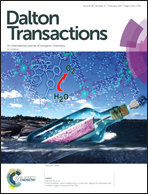Cu(i) and Ag(i) complex formation with the hydrophilic phosphine 1,3,5-triaza-7-phosphadamantane in different ionic media. How to estimate the effect of a complexing medium†
Abstract
The complexes of Cu(I) and Ag(I) with 1,3,5-triaza-7-phosphadamantane (PTA) are currently studied for their potential clinical use as anticancer agents, given the cytotoxicity they exhibited in vitro towards a panel of several human tumor cell lines. These metallodrugs are prepared in the form of [M(PTA)4]+ (M = Cu+, Ag+) compounds and dissolved in physiological solution for their administration. However, the nature of the species involved in the cytotoxic activity of the compounds is often unknown. In the present work, the thermodynamics of formation of the complexes of Cu(I) and Ag(I) with PTA in aqueous solution is investigated by means of potentiometric, spectrophotometric and microcalorimetric methods. The results show that both metal(I) ions form up to four successive complexes with PTA. The formation of Ag(I) complexes is studied at 298.15 K in 0.1 M NaNO3 whereas the formation of the Cu(I) one is studied in 1 M NaCl, where Cu(I) is stabilized by the formation of three successive chloro-complexes. Therefore, for this latter system, conditional stability constants and thermodynamic data are obtained. To estimate the affinity of Cu(I) for PTA in the absence of chloride, Density Functional Theory (DFT) calculations have been done to obtain the stoichiometry and the relative stability of the possible Cu/PTA/Cl species. Results indicate that one chloride ion is involved in the formation of the first two complexes of Cu(I) ([CuCl(PTA)] and [CuCl(PTA)2]) whereas it is absent in the successive ones ([Cu(PTA)3]+ and [Cu(PTA)4]+). The combination of DFT results and thermodynamic experimental data has been used to estimate the stability constants of the four [Cu(PTA)n]+ (n = 1–4) complexes in an ideal non-complexing medium. The calculated stability constants are higher than the corresponding conditional values and show that PTA prefers Cu(I) to the Ag(I) ion. The approach used here to estimate the hidden role of chloride on the conditional stability constants of Cu(I) complexes may be applied to any Cu(I)/ligand system, provided that the stoichiometry of the species in NaCl solution is known. The speciation for the two systems shows that the [M(PTA)4]+ (M = Cu+, Ag+) complexes present in the metallodrugs are dissociated into lower stoichiometry species when diluted to the micromolar concentration range, typical of the in vitro biological testing. Accordingly, [Cu(PTA)2]+, [Cu(PTA)3]+ and [Ag(PTA)2]+ are predicted to be the species actually involved in the cytotoxic activity of these compounds.



 Please wait while we load your content...
Please wait while we load your content...